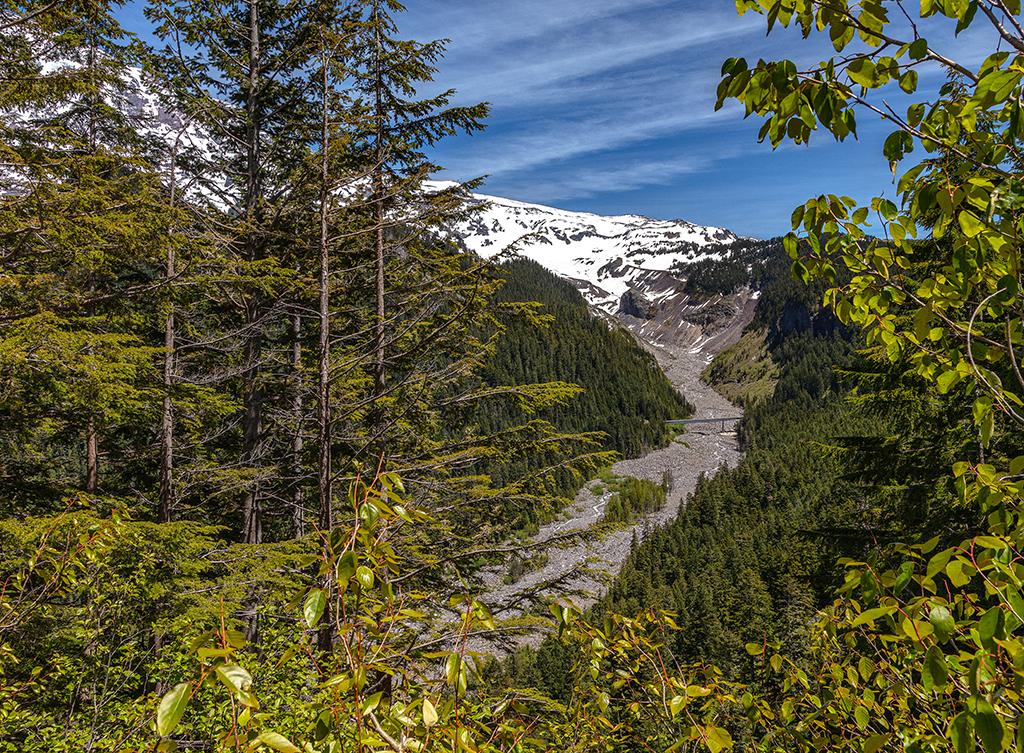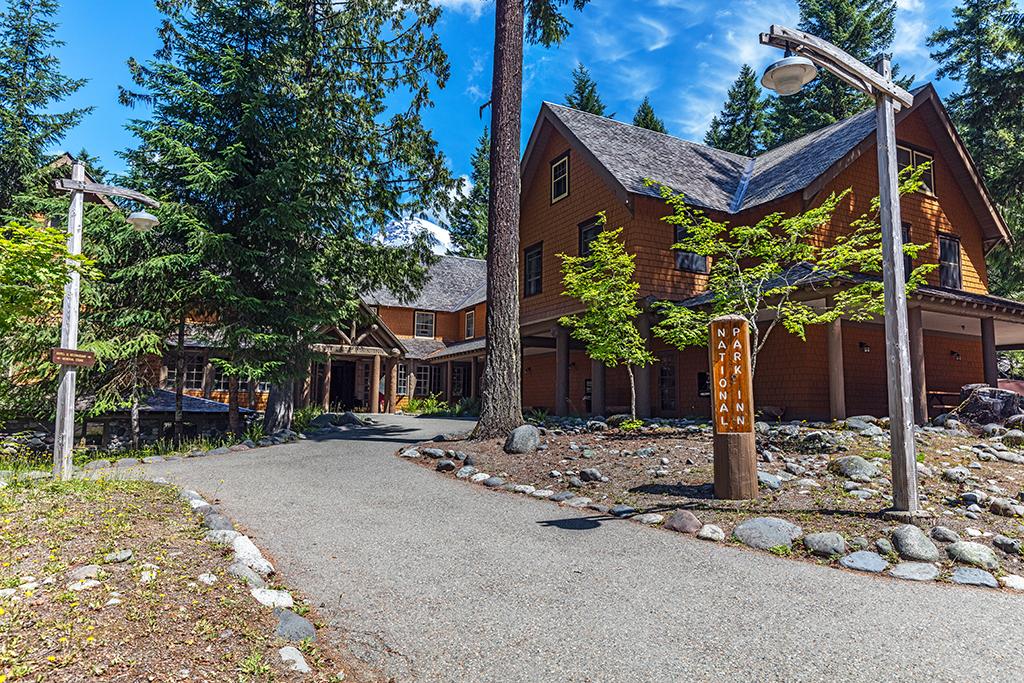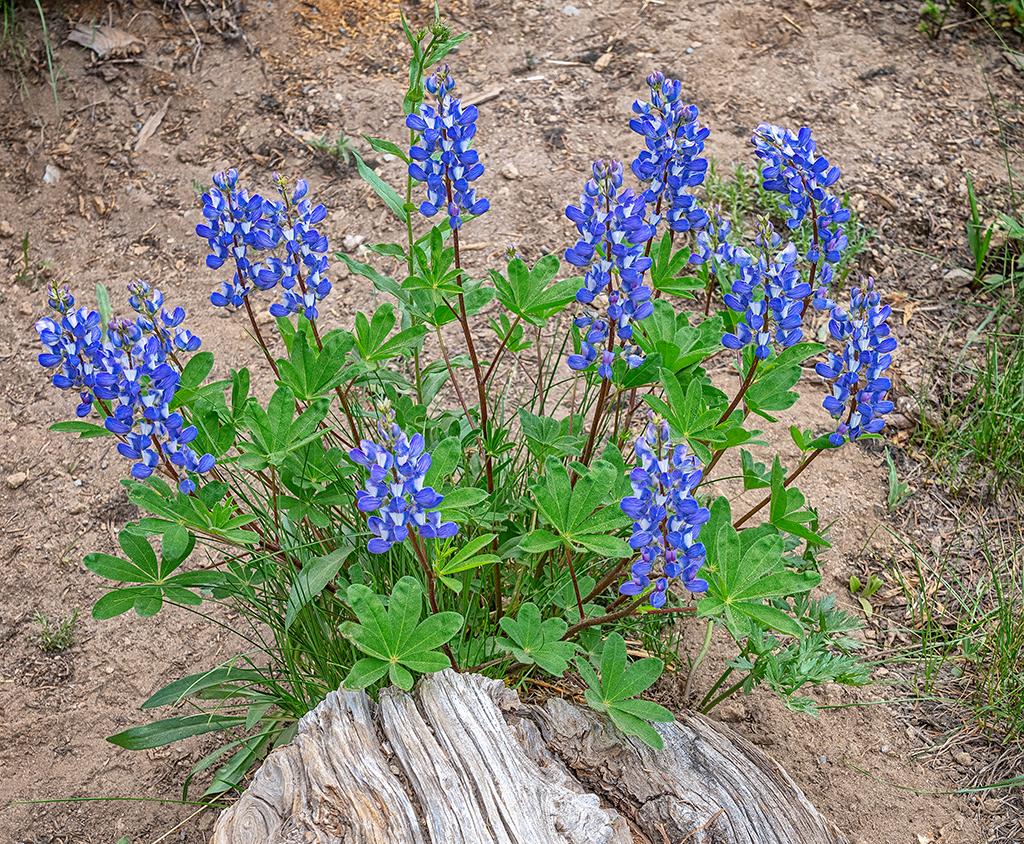As you drive toward, or fly over, Washington state, you can’t help but turn your eyes toward “The Mountain.” Known as Tahoma, Takhoma, Tacoma, Ta-co-bet, Taqo ma, Tkobed, Taqo bid, Tkomen, Nutselip, Pshwawanoapami-tahoma, Tahoma by the Northwest Native tribes, this iconic volcano for which Mount Rainier National Park is named, is considered active and is also the most-glaciated peak in the contiguous U.S. There is so much to see and do in this national park, the first-time visitor might be a little overwhelmed and stuck for a starting point. The Traveler’s Checklist can help you with suggestions to make the most of your time exploring this park.

"The most extravagantly beautiful," Mount Rainier National Park / Rebecca Latson
- Stop at the pullouts and view areas for scenes of rivers, streams, and landscape vistas with and without views of Mount Rainier. You’ll see different environments as you progress from low to high elevations. A couple of must-see stops include Glacier Bridge, about 5 miles (8.05 km) up the road from Longmire. DO NOT stop on the bridge. Instead, park in the large lot to your right, just before crossing the bridge on your way to Paradise. Or at the large pullout to your left, just before the bridge as you make your way down from Paradise. You’ll see up and down the Nisqually River’s route from the Nisqually Glacier at this spot. Drive about a mile (1.61 km) or so further up the road and take the short, one-way Ricksecker Point loop drive, parking in the lot at the beginning of the loop for an overhead view of Glacier Bridge and the Nisqually River way down below.

The view from Ricksecker Point, Mount Rainier National Park / Rebecca Latson
- Go hiking. There are a multitude of day hike options from which to choose, depending where you are in the park. The most popular trails are:
- Grove of the Patriarchs Trail near the Stevens Canyon Entrance – currently CLOSED due to damage to the suspension bridge across the Ohanapecosh River.
- Fremont Mountain Trail, Burroughs Trail, Dege Peak Trail in the Sunrise area.
- Skyline Loop, Alta Vista, and Myrtle Falls (via Skyline Loop) trails in the Paradise area
- Tolmie Peak and Spray Park trails in the Mowich Lake area
- Carbon River Trail in the Carbon River area
- Trail of Shadows and Rampart Ridge trails in the Longmire Historic District
- Twin Firs Trail between the Nisqually Entrance and Longmire Historic District

A view of "The Mountain" from Dege Peak Trail, Mount Rainier National Park / Rebecca Latson
- If you feel like really getting away from it all, why not backpack some or all of the 93-mile-loop (149.7 km) Wonderland Trail.
- Spend a night in one of the two in-park historic lodges: Paradise Inn and National Park Inn. Both were built in response to the growing tourism industry after the establishment of his national park in 1899. The National Park Inn was built in 1906 and its Annex in 1917, and the Paradise Inn was constructed in 1917. Fire destroyed the main lodge of the National Park Inn in 1926, so now the Annex serves as the main lodge.

The former Annex for the National Park Inn now serves as the main lodge building, Mount Rainier National Park / Rebecca Latson
- Visit both the Paradise and Sunrise areas of the park, as they provide different perspectives of “The Mountain.” Take a couple of days for this – one day at Paradise and one day at Sunrise.
- Look for wildflowers. Peak bloom is difficult to predict since it’s dependent upon weather and precipitation patterns, but generally, you’ll see a plethora of wildflowers between mid-July into August, including glacier lilies, avalanche lilies, beargrass, phlox, tiger lilies, scarlet and magenta paintbrushes, and penstemons. If you plan on some wildflower photography, bring along your SLR’s macro or telephoto lens for close-ups, or use the macro mode on your point-and-shoot camera. Smartphones also work well for close-ups.

Beautiful blue lupine is just one of the wildflower species you can spot at Mount Rainier National Park / Rebecca Latson
- Watch for waterfalls. Because of Mount Rainier’s glaciers and snowpack, there are an “untold number” of waterfalls, named and unnamed. Just prior to the Bench and Snow Lake trail pullout/parking area along Stevens Canyon is Sunbeam Falls along Sunbeam Creek. If you are driving the Longmire-to-Paradise-Corridor road, you’ll be able to view two of the most popular waterfalls in the park: Christine Falls and Narada Falls. Get there early, because parking fills up quickly for both waterfalls. Parking for Christine Falls is really small, and you should slow down and watch for people walking alongside the road in that area. Another popular waterfall is Myrtle Falls, located on a paved trail just 0.4 mile (0.64 km) from Paradise Inn. Early morning is the best time to view this waterfall before the crowds start gathering around the tiny view area. If you are photographer, waterfalls are great spots to practice your silky water technique.

Myrtle Falls in the Paradise Area is one of the popular waterfalls you will see in Mount Rainier National Park / Rebecca Latson
- Stop off and visit the Longmire Historic District, which includes a museum, National Park Inn, and Wilderness Information Center. Take the walking tour, including the suspension bridge over the Nisqually River. Cross the road from the inn and walk the 0.7-mile (1.13 km) Trail of the Shadows Loop from which joins the Rampart Ridge trailhead.
- Climb Mount Rainier. It’s quite an achievement to be able to say you’ve climbed this 14,410-foot-tall (4,392 m) volcano. Climbing “The Mountain” takes planning and preparation and is not something to do on the spur of the moment. Hiring a guide service can help take the headache out of planning a climb, plus guide services offer basic instructions and handle all permitting.
- Go stargazing and photograph the stars and Milky Way at spots along the Stevens Canyon Road, at Reflection Lakes, or up at the Paradise or Sunrise areas. For tips on night photography, click here.

"The Mountain" beneath a starry sky, Mount Rainier National Park / Rebecca Latson
- Get up early and watch a sunrise. Any of the places for stargazing are also great spots to watch the sun bathe “The Mountain” with shades of gold and red sunlight.

Sunrise seen along the Sourdough Ridge Trail in the Sunrise Area of Mount Rainier National Park / Rebecca Latson
- Try visiting Mount Rainier National Park during winter for a different perspective of the park as well as a new set of activities (snowshoeing, downhill and cross-country skiing, and sledding). Although most park roads will be closed, the Nisqually Entrance is open year-round, as is the National Park Inn at Longmire. The gates from Longmire to Paradise are open four days a week, from 9 a.m. and close at 5 p.m., depending upon the weather conditions.

Snowshoeing at Paradise, Mount Rainier National Park / Rebecca Latson





